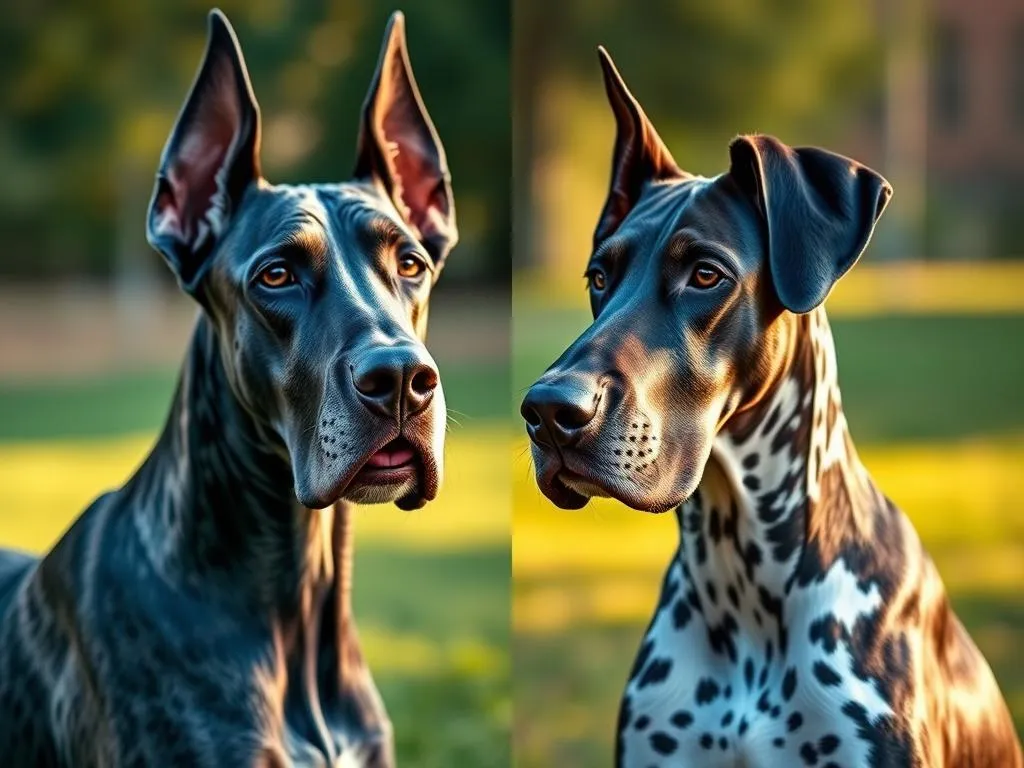
Great Danes are one of the most recognizable dog breeds in the world, known for their impressive size, gentle temperament, and regal presence. Understanding the differences between American vs European Great Dane lines is essential for potential owners, as these distinctions can affect everything from physical appearance to temperament and health. In this article, we will explore the characteristics, health considerations, and training needs of both American and European Great Danes to help you make an informed decision.
History of the Great Dane
Origins of the Breed
The Great Dane traces its roots back to ancient times, with evidence of large dog breeds existing in the Mediterranean region as far back as 3000 BC. The breed’s modern development began in Germany, where it was refined by nobility for hunting large game, such as wild boar. The Great Dane was created by crossing various breeds, including the Irish Wolfhound and the Mastiff, resulting in a dog that was both powerful and agile.
Development of American and European Lines
As the Great Dane made its way to the United States, breeders began adapting the breed to fit the preferences of American families. This adaptation led to the emergence of two distinct lines: the American Great Dane and the European Great Dane.
The American Great Dane typically exhibits a more refined appearance, with a focus on a longer, leaner build and a greater variety of coat colors. In contrast, the European Great Dane is bred according to stricter standards emphasizing a robust build, with a wider chest and a more substantial head.
Physical Characteristics
Size and Build
One of the most notable differences between the American vs European Great Dane lies in their size and build.
-
American Great Dane: Generally, males stand between 30 to 34 inches tall and weigh between 140 to 175 pounds, while females are slightly smaller, ranging from 28 to 32 inches and weighing 110 to 145 pounds. The American line often has a more elongated body and longer legs.
-
European Great Dane: Males typically stand between 32 to 36 inches tall and weigh from 140 to 190 pounds, while females usually measure 28 to 32 inches and weigh between 110 to 160 pounds. European Danes tend to have a more robust and muscular build, with a broader chest and thicker neck.
Coat and Color
Both lines of Great Danes come in a variety of colors, but there are some differences in the preferred patterns:
-
American Great Dane: Common coat colors include fawn, brindle, blue, black, and harlequin. The breed often features a more diverse range of color combinations, which are popular among American breeders.
-
European Great Dane: European lines tend to prioritize solid colors and marked patterns. Common colors include fawn, brindle, black, and blue, but the emphasis is often on breed standards that favor specific colorations, such as the classic harlequin pattern.
Grooming needs are similar for both types, requiring regular brushing to minimize shedding and maintain a healthy coat.
Temperament and Behavior
General Temperament of Great Danes
Great Danes are often described as gentle giants. They are known for their friendly and affectionate nature, making them excellent companions for families and individuals alike. Despite their size, they typically exhibit a calm demeanor and a strong desire to be part of the family.
American Great Dane Temperament
The American Great Dane tends to be more playful and energetic compared to its European counterpart. They are known for their sociable nature, often getting along well with children and other pets. Their friendly disposition makes them excellent family dogs, and they thrive on interaction and playtime. However, they may also exhibit some stubbornness, so consistent training is essential.
European Great Dane Temperament
In contrast, the European Great Dane is often regarded as more reserved and serious. This line tends to be more protective of their family, making them excellent watchdogs. While they are still affectionate and loving, they may display a more laid-back demeanor. European Danes generally require proper socialization from an early age to ensure they are comfortable around various people and pets.
Comparison of Temperament
In summary, the key differences in temperament between American and European Great Danes lie in their energy levels and sociability. American Danes are typically more playful and outgoing, while European Danes tend to be more reserved and serious. Both lines are affectionate but may require different approaches to training and socialization.
Health Considerations
Common Health Issues
Like all breeds, Great Danes are prone to certain health issues, which can vary between the American and European lines. Common health concerns for Great Danes include:
- Bloat (gastric torsion)
- Hip dysplasia
- Elbow dysplasia
- Heart conditions (such as dilated cardiomyopathy)
- Osteosarcoma (bone cancer)
Health Concerns in American Great Danes
American Great Danes often face specific health concerns related to their build and breeding practices. They are more susceptible to bloat due to their elongated bodies and deep chests. Additionally, they may have a higher incidence of hip dysplasia, which can lead to mobility issues as they age.
Health Concerns in European Great Danes
European Great Danes, while still susceptible to the same general health issues, often exhibit fewer problems with bloat thanks to their sturdier build. However, they can still experience health issues such as heart conditions and joint problems, particularly as they age.
Preventative Care and Lifespan
Preventative care is crucial for both lines of Great Danes. Regular veterinary check-ups, a balanced diet, and maintaining a healthy weight can significantly influence their overall health. The average lifespan of a Great Dane typically ranges from 7 to 10 years, with factors such as genetics, diet, and exercise playing a vital role in longevity.
Training and Socialization
Importance of Training
Proper training and socialization are essential for the development of a well-adjusted Great Dane. Given their size and strength, an untrained Great Dane can become a challenge to manage. Early obedience training will help them learn commands and appropriate behaviors, ensuring a harmonious relationship with their owners and other pets.
Training Approaches for American Great Danes
American Great Danes benefit from positive reinforcement training methods. They respond well to treats, praise, and playtime as rewards for good behavior. Consistency in commands and routines is crucial, as this breed can be somewhat stubborn. Engaging training sessions that incorporate play can help maintain their attention and enthusiasm.
Training Approaches for European Great Danes
European Great Danes may require a more structured training approach. Given their protective nature, early socialization is critical to ensure they are comfortable around various people and environments. Consistent training with clear boundaries and positive reinforcement can help them thrive as family companions.
Socialization Needs
Both American and European Great Danes require early socialization to develop a well-rounded temperament. Exposing them to different environments, people, and other animals can help prevent behavioral issues down the line. Socialization classes can be beneficial for both lines, allowing them to learn and grow in a controlled setting.
Living Conditions and Exercise Requirements
Ideal Living Environment
Both American and European Great Danes require ample space due to their size. A home with a large indoor area and a fenced yard is ideal. While they can adapt to apartment living, it’s crucial to provide them with sufficient room to move around and play.
Exercise Needs
Daily exercise is essential for Great Danes. They require at least 30 to 60 minutes of moderate activity each day, which can include walks, playtime, or even light jogging.
-
American Great Danes: These dogs tend to have higher energy levels and may require more vigorous exercise to keep them mentally and physically stimulated.
-
European Great Danes: While they also need regular exercise, they may be more content with a leisurely stroll or gentle playtime due to their more laid-back nature.
Suitability for Families and Individuals
Both lines of Great Danes can make excellent companions for families and individuals. However, those with active lifestyles may prefer the more energetic American Great Dane, while individuals or families looking for a calmer presence may find the European Great Dane to be a better fit.
Cost of Ownership
Initial Costs
The initial purchase price of a Great Dane can vary significantly between the American vs European Great Dane. American Great Danes may range from $1,000 to $3,000, depending on the breeder and lineage. European Great Danes, on the other hand, often come with a higher price tag, typically ranging from $2,000 to $5,000, due to stricter breeding standards and health testing.
Ongoing Expenses
Owning a Great Dane comes with ongoing expenses that can add up over time:
-
Food: Given their size, Great Danes require a substantial amount of high-quality food. Expect to spend around $100 to $200 monthly on food.
-
Grooming: Regular grooming sessions and supplies may cost between $50 to $100 monthly.
-
Veterinary Care: Routine vet visits, vaccinations, and preventive medications can average $500 annually.
-
Insurance: Pet insurance can range from $30 to $100 monthly, depending on coverage and provider.
Long-term Financial Commitment
Owning a Great Dane is a long-term financial commitment. Between initial costs and ongoing expenses, potential owners should be prepared for a budget of several thousand dollars annually. This financial responsibility is essential to ensure that your Great Dane receives the best care possible throughout their life.
Conclusion
When considering the American vs European Great Dane, it’s vital to evaluate the differences in appearance, temperament, health, and suitability for your lifestyle. Both lines can make wonderful companions, but their unique characteristics may better align with certain owners’ preferences and living situations. Ultimately, whether you choose an American or European Great Dane, these gentle giants will undoubtedly enrich your life with their loving and loyal nature. Consider your individual lifestyle, preferences, and the specific traits of each line to make the best decision for you and your future canine companion.









